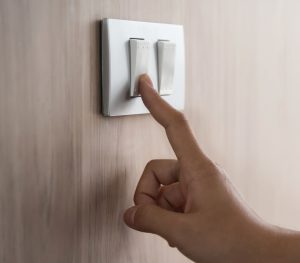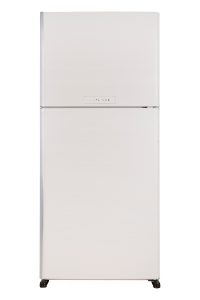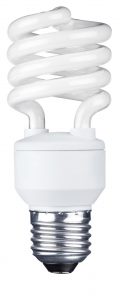
Not only is the tenth month of the year literally “cool” (autumn IS just around the corner!), it’s cool for a few other reasons. We celebrate cooperatives and energy awareness this month. Kids and candy lovers alike look forward to trick-or-treating at month’s end. And, a little known holiday, dedicated to one of our germiest appliances, gives us reason to spend some time in the kitchen on Halloween’s eve.
A celebration of the cooperative difference

Indiana’s electric cooperatives believe in neighbors helping neighbors. That’s just another way of saying we’re committed to our communities, and it’s central to everything we do.
October is National Co-op Month, which is a perfect time to highlight our commitment to the local communities we serve.
Your electric cooperative keeps the power flowing, providing lights; running stoves, heaters and air conditioners; and energizing the images we see in the game of the week or our favorite television series.
Sure, that’s our main mission, but when you look around your neighborhood, there’s a good chance the folks at your electric co-op have played some small role in helping to make things better in other ways.
It’s often co-op crews that show up with bucket trucks before the season to check the lights and change the bulbs at high school football fields, making night games possible.
Because we’re your neighbors, our kids attend the same schools. Members of our co-op staffs are right there with you at parent-teacher organization fundraisers. You can bet you’ll hear their voices among the bidders at 4-H/FFA project auctions, and some of those energy efficiency projects at the science fair might just be co-op inspired.
We see the same challenges and depend on the same services you do. At the fire hall or emergency medical services garage, you’ll see some of our lineworkers, field representatives and member services staffers listed on the roster of volunteers. You might also see a sign along the highway indicating that a co-op team helps to keep that stretch of roadway clean.
We work with members to solve the problems in our communities that members see. Whether its filling food pantries, collecting school supplies and holiday gifts or supporting temporary housing for families in crisis, in some small way, your local electric cooperative is involved.
But none of this is new. In fact, it’s why your electric co-op is not just some company. Since the beginning, the people behind the co-op have regularly gone through their communities looking for ways to meet needs.
Reliable, affordable power is still one of those needs, but listening to members still helps us to learn about new ones.
These days, we do that through social media or through conversations member services representatives have with members on the telephone or at our service center counters. Staffers are also listening for your concerns at churches, fast food restaurants and on the sidelines at the local ballfields.
With us, whether you grew up on our lines or just moved into our service territory weeks or months ago, you’ll always have a voice. When we listen to you, we find out how we’re doing and that lets us know when we get it right, or need to make changes to keep from getting it wrong.
We care about the things you care about, because we live here too. We get involved early on the big economic development issues. Our engineers, lawyers and accountants work with other community leaders to create new jobs and launch new industries.
But our commitment to community means we should be there to help with the small things too.
At the neighborhood level, it’s the little things that really make a difference. That’s always been the co-op way. Each and every one of us connected to the co-op is every bit as committed to being here and staying involved each and every day.
Get in the energy efficiency habit

It’s possible you’re wasting a lot of energy at home without even realizing it. October is Energy Awareness Month, the perfect opportunity to change your wasteful habits.
Just as some foods contain hidden calories — so you gain weight without intending to cheat on your diet — you could be using electricity when you don’t need or want to.
The solution: Survey every electric appliance, plug and light fixture in your home to learn whether you’re using them in the most efficient way. Here’s how to start:
Unoccupied rooms. Get your family in the habit of turning lights off when they leave the area. Likewise, don’t leave porch lights or landscape lighting on during the day. Can’t remember to flip the switch? Install timers, photo cells or occupancy sensors that will turn lights on and off.
Thermostat. Why keep an empty house cozy and warm? Install a programmable thermostat that will kick the heat up in the morning right before you wake up; scale it back when everybody leaves for school and work; crank it back on when it’s time for the family to get home at the end of the day; and ease it lower at bedtime.
Windows. Every crack and tiny hole on the inside of an exterior wall is a place where cold air can sneak into your house and mix with the comfortable heated air that you paid to warm up. Caulk around windows, electrical outlets and the points where cables and other cords come into the house.
Insulation. Your builder probably installed plenty when your house was built. How long ago was that? Over time, attic and slab insulation can diminish or fall away from the surface it was meant to protect. Once that happens, warm air can escape through the roof or floor and cold air can get in. Check your insulation at least once a year and add or replace it as needed.
How creepy is your refrigerator?

What’s inside your refrigerator might be the scariest thing you see this Halloween.
Oct. 30 is Haunted Refrigerator Night, and it’s a great time to clean your ’fridge — all the way to the backs of the shelves.
Unplug the appliance, pull it away from the wall, and use soap, white vinegar and water to scrub the shelves and soak the bins. Dry them thoroughly before replacing them.
To sanitize the appliance, wipe it down — inside and out — with a mixture of water, chlorine bleach, baking soda and borax.
And do it often — not just on Halloween. A clean refrigerator will run more efficiently than one full of spills, grime and even mildew.
Some more tips:
Use a vacuum cleaner or soft brush to clean the coils located on the back of the refrigerator once a year.
Slip your vacuum cleaner hose attachment under the refrigerator to clean the condenser coils. If it won’t fit, stretch a rubber band around an old sock and attach it to the end of a yardstick. Slide the stick under the refrigerator to clean the condenser coils
And while you’re giving the refrigerator a once-over, check the gasket (the soft plastic piece that seals the door to the body of the refrigerator) for gaps and improper fit. A trick: Place a dollar bill between the gasket and the door. Close the door and tug on the dollar. If it doesn’t drag as you pull it out, the gasket may be worn. Replace it.
When you’re finished with the slimy chore, plug the refrigerator back in. Leave space between the coils and the wall to allow for air flow.
Keep the refrigerator away from heating vents, windows and the stove. The extra heat requires the unit to spend more energy to cool food.
A tip: Empty the whole refrigerator so you can see every spill, drip and storage container of expired food.
Energy vampires can suck your wallet dry

This Halloween, be aware that the hungry little vampires who ring your doorbell aren’t the only ones you need to be afraid of.
Energy vampires inside your home are sucking electricity right out of the wires — for no good reason.
Energy vampires are appliances and electronic devices that you leave plugged in when nobody is using them. Even though they’re turned off, they still use small amounts of energy.
When you consider how many unused devices are plugged in around your home, their energy use can add up. In fact, they can add 10 percent or more to your monthly electric bill.
So when you turn something off, unplug it, too — unless it has to be on all the time, like the refrigerator.
To save you from a witch hunt, here is a list of the most likely vampires in your house:
• Computers, modems, routers, printers and other related equipment.
• Your flat-screen TV. The larger it is, the more energy it uses, even when turned off.
• Home theater equipment, including surround-sound devices.
• Your cable or satellite TV box.
• Anything with a digital time display, like your microwave oven or DVD player.
If an electrical device has a continuous display, like a digital clock; if it charges batteries, like your mobile phone charger; or if it has a remote control, like your TV — it’s a vampire.
Here are some easy ways to slay those vampires:
• Unplug any appliance or electronic device whenever you’re not using it, unless there’s some reason to leave it plugged into the wall. It’s not practical, for example, to unplug your cable box and wireless router. But you can unplug your TV, stereo, laptop, countertop kitchen appliances and cell phone chargers when they’re not in use.
• Use power strips. Plug the devices that can be turned off into power strips so all you have to do is turn one thing off instead of going around the room switching everything off one at a time.
• Setting computers and video game consoles to sleep mode in case you forget to unplug them at the end of the day will save some energy.
• Choose new appliances and electronics that use less “standby” power than your old ones. Any equipment marked with the Energy Star® seal has that feature.
An illuminating DIY costume idea

BE A LIGHTBULB FOR HALLOWEEN
Believe it or not, not everyone has gotten the message that LED light fixtures and compact fluorescent lightbulbs are way more energy efficient than those old, incandescent bulbs that we used to use around the house.
Make sure your neighbors know this Halloween by dressing up as an energy-efficient lightbulb when you take your kids out to trick-or-treat.
You can make your own costume by dressing in a solid color as the background, such as all white to blend in with the bulb, or all black to make it stand out. Next, create the base of the bulb out of two large pieces of cardboard — one for the front of you, and one for the back. Use silver spray paint and black markers to create the illusion of spirals. Attach both pieces to a belt and tie around your waist.
Now it’s time for the white spirals of the bulb. There are several things you can use, depending on what you have around. Try using sturdy wire or strong pipe cleaners and bend them in twists around your torso, starting from the base of the bulb. Glue white pillow stuffing around the wires to make them thick and white. Or try using a foam noodle pool toy, spray-painted white and fastened to your costume at the shoulder.
Whatever the heights of the twists, leave space between each so that you can see clearly and your arms can move freely.
And if you’re decorating your home with orange and black lights this season, choose ultra-efficient LED lights.


